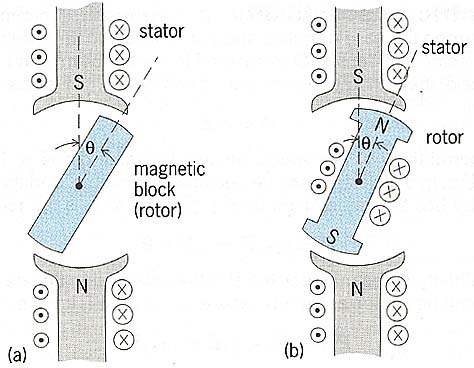AMAZON multi-meters discounts AMAZON oscilloscope discounts
Any form of apparatus, having a rotating member, which generates, converts, transforms, or modifies electric power. Essentially all of the world’s electric power is produced by rotating electrical generators, and about 70% of this energy is consumed in driving electric motors. Electric machines are electromechanical energy converters; generators convert mechanical energy into electrical energy and motors convert electrical energy into mechanical energy.
An electric machine can be constructed on the principle that a magnet will attract a piece of permeable magnetic material such as iron or magnetic steel. In fig. a (below), a pole structure is shown along with a magnetic block that is allowed to rotate. The magnetic block will experience a torque tending to rotate it counter clockwise to the vertical direction. This torque called a reluctance or saliency torque, will be in the direction to minimize the reluctance of the magnetic circuit. In fig. b (below), a winding is added to the rotor (the part which is allowed to rotate). In this case there is an additional torque on the rotor in the counterclockwise direction produced by the attraction of opposite poles. This torque will be approximately proportional to the sine of the angle θ. While the magnets in the illustration are electromagnets, permanent mag nets could be used with the same effect.
In these examples, if the rotor were allowed to move under the influence of the magnetic forces, it would eventually come to rest at an equilibrium position, θ = 0. Since most applications require continuous motion and constant torque, it is necessary to keep the angle between the rotor magnetic field and the stator magnetic field constant. Thus, in the above examples, the stator magnetic field must rotate ahead of the rotor.
Although there are many variations, the three basic machine types are synchronous, induction, and direct-current machines. These machines may be used as motors or as generators, but the basic principles of operation remain the same. The synchronous machine runs at a constant speed determined by the line frequency. There is an alternating-current winding (normally on the stator) and a direct-current winding (normally on the rotor).

Above: Devices illustrating principles of electric machines. (a) Permeable
rotor and stator with magnetic pole structure. (b) Device with magnetic
pole structures on both stator and rotor.
The induction machine is another alternating-current machine which runs close to synchronous speed. The alternating-current winding of the stator is similar to that of the synchronous ma chine. The rotor may have an insulated winding (wound rotor) but more commonly consists of uninsulated bars embedded in a laminated structure and short-circuited at the end (squirrel cage). There is normally no voltage applied to the rotor. The voltages are produced by means of Faraday’s law of induction. In an induction motor the stator-produced flux-density wave rotates slightly faster than the rotor during normal operation, and the flux linkages on the rotor therefore vary at low frequency. The rotor currents induced by these time-varying flux linkages pro duce a magnetic field distribution that rotates at the same speed as the stator-produced flux wave.
In a direct-current motor, direct current is applied to both the rotor and the stator. The stationary poles on the stator produce a stationary magnetic field distribution. Since the angle between the stator-produced poles and rotor-produced poles must remain constant, the direct-current machine uses a device known as a commutator which switches the current from one rotor circuit to another so that the resulting field is stationary.